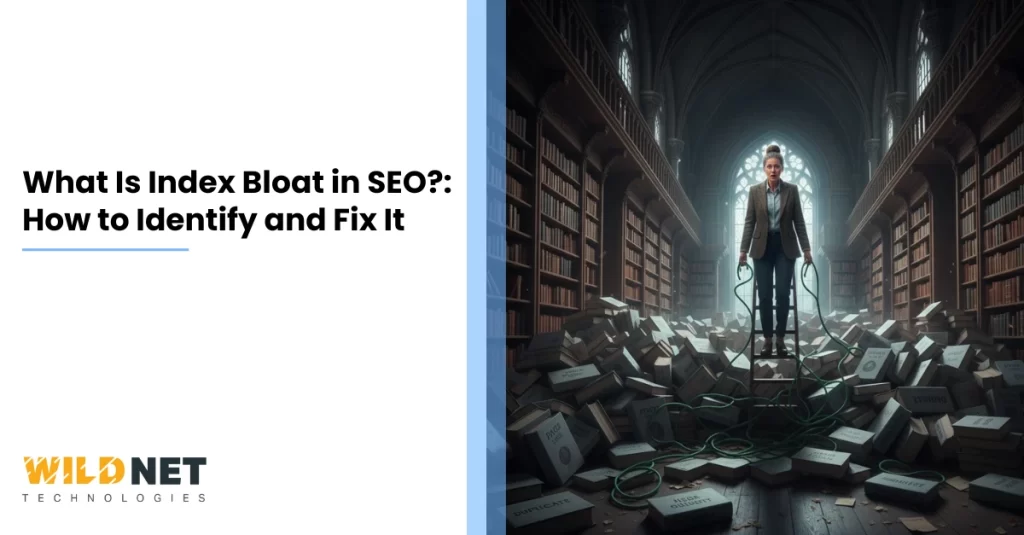Index bloat occurs when search engines index unnecessary or low-value pages on your website. These pages may not serve any real purpose for users or add value to your SEO efforts, but they still get crawled and indexed by Google.
This leads to wasted crawl budget, diluted authority, and sometimes even lower rankings for your important pages.
In simpler terms, index bloat is like clutter in your closet. The more junk you have, the harder it becomes to find what truly matters.
Why Index Bloat Matters
When your site has index bloat, Googlebot spends time crawling useless URLs instead of those that help you rank. This can negatively affect:
- Crawl Efficiency: Google may not reach important pages frequently enough.
- Search Rankings: Thin or duplicate pages can affect your overall SEO performance.
- User Experience: Visitors may land on outdated, duplicate, or irrelevant pages.
To maintain a healthy and high-performing website, spotting and fixing index bloat should be a top priority.
Common Signs of Index Bloat
Here are some telltale signs that your website might be suffering from index bloat:
1. Indexed Page Count Is Much Higher Than Expected
One of the most evident signs is when your Google Search Console “Indexed Pages” count is far greater than the number of valuable pages on your site.
For example, if your website has 500 quality pages but Google shows 2,000 indexed URLs, that’s a red flag.
These extra pages could include:
- Filter or search result pages
- Tag archives
- Author pages
- Session IDs and URL parameters
Compare your sitemap with the indexed URLs to find unnecessary pages.
2. Duplicate or Near-Duplicate Content
Duplicate pages are a common source of index bloat. These may arise from:
- URL parameters like ?sort=price or ?color=red
- Printer-friendly versions of pages
- HTTP vs HTTPS or www vs non-www versions
- Same product listed under multiple categories
Such pages confuse search engines and waste your crawl budget. Implementing canonical tags and using the URL Parameters tool (or robots.txt) can help control this issue.
3. Thin or Low-Quality Pages Indexed
Pages with little or no valuable content — like empty category pages, pagination URLs, or old blog tags can cause index bloat.
Ask yourself: Would this page add any value to a user coming from Google?
If the answer is no, it likely shouldn’t be indexed.
Deindexing thin pages helps concentrate authority on your important ones.
4. Excessive Parameter or Dynamic URLs
E-commerce and CMS-driven sites often generate hundreds of dynamic URLs with query strings.
Example:
example.com/products?sort=latest&color=blue&size=medium
Each combination can create a new indexed page, resulting in thousands of unnecessary URLs.
To fix this, use:
- Canonical tags pointing to the main URL
- Robots.txt rules to block parameter-based pages
- The “noindex” meta tag for non-essential filters
5. Indexed Internal Search Result Pages
Many websites accidentally allow their on-site search pages to be indexed. These pages contain dynamically generated results without a standalone value to users or search engines.
For example:
example.com/search?q=shoes
Such pages can quickly multiply and cause severe index bloat. To prevent this issue, use noindex and follow meta tags.
6. Outdated or Orphaned Content Still Indexed
Old product pages, expired offers, or outdated blog posts may remain indexed long after they’re relevant.
You can identify these pages by:
- Reviewing Google Search Console’s “Crawled but not indexed” or “Indexed but not submitted” reports
- Checking for old URLs that still receive impressions but no clicks
Remove or redirect outdated content to keep your index clean and relevant.
7. Tag, Author, or Archive Pages Over-Indexed
While archive pages can help users navigate content, having them all indexed often leads to duplicate or near-duplicate issues.
If your site uses WordPress, you might have multiple tag and author pages indexing the same articles repeatedly.
To fix this, disable indexing for tags and archives using your SEO plugin or robots.txt file.
How to Fix Index Bloat
Once you’ve identified the signs, take the following actions:
- Audit Your Indexed Pages
Use Google Search Console’s “Pages” report and site:yourdomain.com searches to identify unnecessary URLs. - Update Your Robots.txt File
Block crawling of dynamic or parameter-driven URLs that add no value. - Apply “Noindex” Meta Tags
Use these on pages like search results, filters, or archives to keep them out of Google’s index. - Set Canonical Tags
Help Google understand which version of a page is the primary one. - Regularly Review and Prune Content
Remove outdated, duplicate, or thin pages. Redirect URLs when necessary. - Monitor Crawl Stats
Check your crawl stats in Google Search Console to ensure Googlebot spends time on the right pages.
Why Preventing Index Bloat Improves SEO
A well-optimised index means:
- Google finds your best pages faster
- Your site’s authority isn’t spread too thin
- User experience improves with cleaner navigation.
When your index is clean and efficient, your site becomes more discoverable and ranks better for your target keywords.
If you need professional help optimising your website structure, improving crawl efficiency, and boosting overall search performance, consider partnering with Wildnet Technologies. This trusted Digital Marketing Company delivers advanced SEO solutions.
With a team of experienced SEO professionals, Wildnet ensures your website remains technically sound, search engine friendly, and primed for long-term growth in the ever-evolving digital landscape.
Conclusion
Index bloat is a silent SEO killer. It is often overlooked, but it can drag down even the most optimised websites.
By identifying and resolving excess indexed pages, you ensure that Google focuses on your most valuable content, improving your site’s visibility, speed, and overall performance.
Clean up your index, and your SEO results will thank you.
FAQ
Ques 1. What causes index bloat?
Ans : Index bloat is caused by duplicate pages, dynamic URLs, thin content, and unoptimized site structures that allow unnecessary pages to be indexed.
Ques 2. How can I check if my website has index bloat?
Ans : Use Google Search Console’s “Pages” report and compare the number of indexed URLs with your sitemap. A large discrepancy indicates potential bloat.
Ques 3. Is index bloat harmful to SEO?
Ans : Yes. It wastes crawl budget, dilutes page authority, and may lower rankings for valuable pages.
Ques 4. How do I prevent index bloat on an e-commerce website?
Ans :Block faceted navigation, add canonical tags, and use “noindex” for product filters or internal search pages.
Ques 5. How often should I audit for index bloat?
Ans : Every 3–6 months. Regular audits ensure new or dynamic pages don’t clutter your index over time.
Read more







